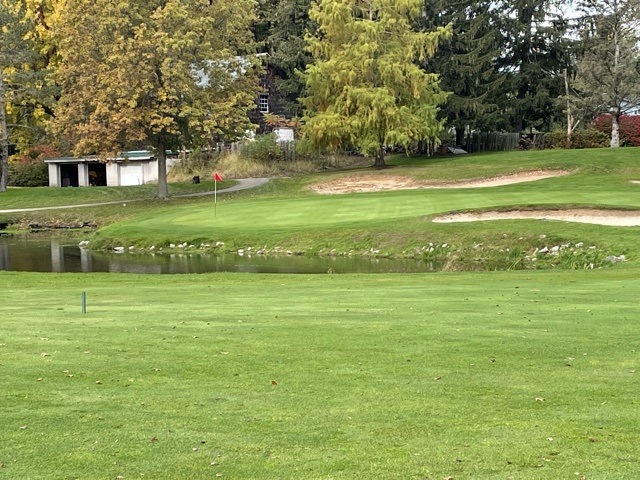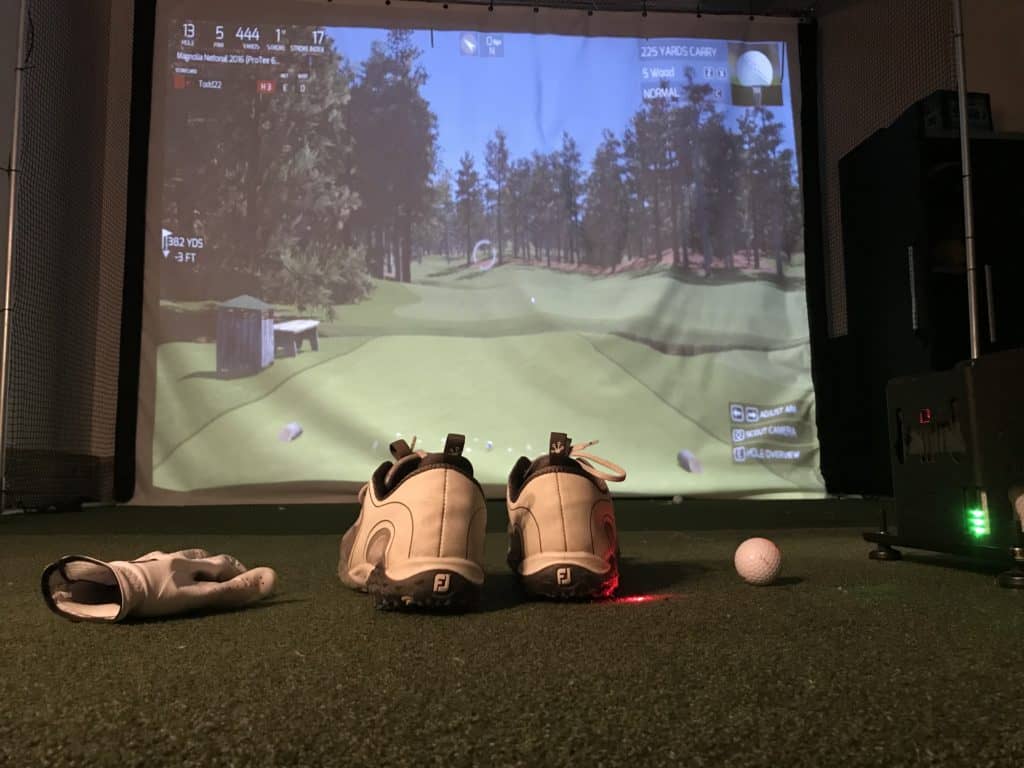The 50 yard pitch shot can drive us crazy in the game, but there can be a simple way to hit the shot. Here is the formula we have experienced to hit the shot that is acceptable and puts us in a good position to make the next putt:
- Assess the complete situation (lie, amount of green to work with, course conditions)
- Select the right shot to increase your chances of a quality shot (3 options)
- Select the right club to match the optimum shot.
- Take some practice swings to assess how the club goes through the grass.
- Build your confidence and vision.
Some golfers really struggle with shots that are less than a full swing.
The good news is that the 50 yard pitch shot does not need to be a difficult shot. With the right steps and the right approach, you can master this shot and have it be a strength of your game.
Could you imagine stepping up to the 50 yard pitch shot with confidence! You can get to the level where a 50 yard pitch shot becomes an opportunity to hit the ball inside of 10 feet and give yourself a makeable putt to make that birdie or save your par.
How To Hit A 50 Yard Pitch Shot
Update: In addition to the 5 tips above, I would also like to add to keep moving through the shot. Too many golfers become short and quick through the shot and stop just past impact. When the conditions aren’t ideal, sometimes the club can stick behind the shot and end up with a really bad result. If this is the case, have the main swing thought to keep moving and finish the shot.

Step #1: Assess the complete situation
The best golfers are able to adjust to each unique situation on a golf course. There are very few times in the game of golf where the situation is exactly the same. One time you might have a good lie, but a difficult pin location and the next time you might have a poor lie with an easy pin location.
There are so many variables in golf, our best option is to be a good decision maker and pick the shot that fits our game and the situation. As you walk to the ball, take it all in. What does the green look like, where is the pin location, what is the wind doing, how are you feeling about your game at this point.
When to use a 60 degree wedge!
Below are the reference points we use:
- What lie do I have? Thick rough, thin fairway, is there grass right behind the ball?
- How much green is there to work with? How far do I want to fly the ball?
- Are the greens firm and fast, or soft and slow?
- Are there bunkers or other hazards that I must carry?
- How much break is there in the green and where do I need to aim?
Now that we have completely assessed the situation, let’s talk about picking the right shot.
Step #2: Select the right shot to increase your chances of a quality shot.
Now that we understand what we are facing, let’s move to selecting the right shot. Most golfers have three options at this stage.
- The higher lofted shot that will need to fly further and will stop quickly.
- The medium lofted shot that will fly around 40 yards and might hop and skip another 10 yards.
- The low lofted shot that might fly only 25-30 and roll the rest of the way.
Some options might quickly be eliminated. For example (see image below), if there is a water hazard directly in front of the shot, the only option might be the higher lofted shot. However, on the very next hole, you might face the same distance and have plenty of green to work with and a flat front to the green. In this situations, the lower or medium lofted shot might be your best option.
As part of this process of selecting the right shot, you have to complete a quick self assessment of your game.
- How are you feeling that day?
- Are you confident in the higher lofted shot?
- What shot carries the most reward and which shot carries the most risk?
- Is the high risk shot worth it?
Ultimately, the goal for your game should be to develop all three shots and have equal confidence in each of the three. This will allow you to select the shot that best matches the hole and the situation.

Step #3: Select the right club to match the optimum shot
Most golfers carry multiple wedges in their bag. When you face the 50 yard pitch shot, the most reasonable clubs are one of the following:
- The 60 degree lob wedge
- The 56 degree sand wedge
- The 52 degree gap wedge
- The 48 degree pitching wedge
The club you select will often have to match up with the lie from par 1, the shot from par 2 and now we have arrived at what the best option is.
Once again, the golfer will consider what is the best shot for their current skill level and their experience that day. I know I select my 60 degree lob wedge a high percentage of the time and will close down the loft a little bit to ensure I make clean, crisp contact, yet have enough loft to help the ball stop in time.
Lob wedge vs pitching wedge (Key Differences)
Step #4: Take some practice swings to assess how the club goes through the grass
Now that you have assessed the complete situation, selected the right lofted shot and have the club to match that loft, it is time to test the grass around the ball. If you are in the rough, try to find a patch that replicates your lie the most. Take 3-5 practices swings back and through and get a feel for how the club will react with the grass.
If you are in the fairway, test for the firmness to ensure you have the club with the right amount of bounce on it. Without taking 3-5 divots, get a feel for how the club will react to the contact with the ground.
The next time you are at a PGA Tour event, take note of how many practice swings the professionals take inside of 100 yards. You will see an increase in rehearsals the shorter the shot and the more difficult the lie is.
Step #5: Build your confidence and vision
The good news about shots inside of 100 yards is that it doesn’t take a great athlete or one with a ton of swing speed to be a master inside of 100 yards. INstead it takes practice, vision and building the confidence in your short game.
The key to success is practicing, having plenty of options, making solid decisions and then committing to the shot that you selected. Post shot, analyze your decision and move on. Make adjustments throughout the round and then remember to practice between the end of your round and before your next round!
Try to focus in on the shot you want to hit, picture the shot in your head and execute the shot. Too often we fear the shot and try to manipulate the club through the hitting zone. Let’s stop that and commit to completing the backswing and downswing and staying smooth through the shot.

Next Steps: Practice!
The next steps are to practice and develop your short game options. Find a short game range where you can hit a 50 yard shot at a target or even better at a practice green.
Test Out the Different Options on the three different shot heights listed above.
- Step 1: Practice for 30-45 minutes with a variety of shots from 50 yards.
- Step 2: Take 10 balls from a variety of spots and see how many times you can chip a ball within 10 feet, but you can only use your 60 degree wedge.
- Step 3: Take 10 balls from a variety of spots and see how many times you can chip a ball within 6 feet, but you should vary your clubs this time.
- Step 4: Repeat steps 2 and 3 until you have a data set of 30 chip shots.
- Step 5: Review the data and your comfort level with both approaches and help this guide you in your decision making process.
- Special Note: You might want to do this over several sessions where you can have data on 100-200 shots and frequently test to see how you feel. You also want to take into consideration your “bad” shots. Were the bad shots much worse with one approach over the other?
What degree wedge is best for chipping?
BONUS: 3 Practice Games/Drills to Utilize to Get Better at the short game
The more you practice the short game shots, the more you will feel comfortable in the 10-60 yard range with those short delicate shots to difficult pin location! Check out these three games below.
Game 1:
A great short game practice drill you can compete against yourself with or a friend is to take one ball and see how many times out of 20 you can get up and down to save your par. Throw the ball to a random spot, hit the chip shot and make the putt. Do this for at least 2 rounds and record your score. Track this over the course of time. If you want to reach your full potential and get better fast, the short game is the real secret. Get started today!
Game 2:
Pick three targets on the green, a short, middle and long target. Take three balls and see if you can get each shot to within three feet of the target. This will help you with distance control and not allow you to get in a grove where you are hitting the same distance every time. While there is some merit with ingraining certain feels around the green, when you get out on the course, you only get one chance to hit that shot. Make it count! See how many times in a row you can do this!
Game 3:
Take three balls and chip to one hole, take your worst chip and see if you can make the putt. Count how many times out of ten you can do this. If you can make somewhere close to 3 out of 10 you are really doing well. This makes you focus for three shots in a row and then make a putt. Compete against yourself and don’t forget to log your scores so you can monitor your progress over time.
Here are 22 other games you mind find helpful in your journey to play your best golf yet!
Short game not your thing? Want to gain speed and add 20-40 yards. Check out one of these two quality options:
Final Thoughts
Golf is a wonderful game. The game is much more fun when you are making pars. The short game is the secret to quick success and sustained success. The best golfers you will find have quality short games and can save pars at least 50% of the time.
There will be some rounds when you are feeling it and can save parts close to 80-100% of the time. It doesn’t take great strength, speed or technique to be a short game expert. Instead, it takes some feel and practice and then confidence when you get over the ball. All three are built through practice and competing and putting in the repetitions to get to that expert level. It can be done!
My Secret To Golf Improvement
Let’s face it, in order to get really good at golf, we must practice frequently. About three years ago, I made the leap and invested in a golf simulator build for my garage. I went with a SkyTrak Launch Monitor and the TGC software and can now play over 100,000 courses including Augusta, Pebble Beach, Bethpage Black, Whistling Straits. St. Andrews and many other of the top 100 courses in the world.
This golf simulator setup, which is more affordable that you might imagine, has been a game changer. I can now play golf everyday of the year regardless of rain, snow, cold weather or time of day. I can practice or play rounds of golf. I can stand in the 11th fairway at Augusta and with the auto-rewind feature I am able to practice my approach shots from various differences.
It is worth checking out through Rain or Shine Golf as they offer some incredible packages along with financing offers that are difficult to beat.
Some direct links to Rain or Shine Golf for pricing and financing:

Take Action – What You Can Do Today to Get Better
What does this mean for you? I believe in the following recipe to get better:
1 – Improve your motion in the golf swing by identifying a golf instructor. Here are some options:
Here is a list of golf instructors that we have reviewed:
2 – Train to swing faster and improve your swing speed. Here are some options:
Looking to gain more Speed and Distance in your swing. Two Options:
3 – Understand course strategy and work to break through your next barrier. Here is a series on breaking through:
We have provided guides on how to break 100, 90, 80 and 70. Check out more below, if interested.
4 – Practice Frequently
Did you know that I build a golf simulator in my garage and have played over 500 rounds of golf on my SkyTrak system? It has been a game changer and one worth checking out. Here are some of my other posts on golf simulators frequently asked questions:
- Is a Golf Simulator Worth It?
- How to Build a Golf Simulator?
- What is the Best Golf Simulator?
- Golf Simulator Accessories?
- How to Build a Golf Simulator for under $7000
- Top 11 Reasons to Buy a SkyTrak
- How to Build a Golf Simulator for Under $1000
- Why Build A Golf Simulator?
- What Space is Needed?
- Can A Golf Simulator Improve My Game?
- How Much Does A Golf Simulator Cost?
- Don’t Forget to Check out our 15 best golf swings of all time.
I am an amateur golfer on a journey to get better, enjoy the game as often as possible and share my passion and knowledge with others. I have coached high school golfers at a high level and have a great passion for the game and want to give back. I enjoy learning about the golf swing and am currently studying to be a certified professional golf instructor. Join me in our journey to get better everyday.

